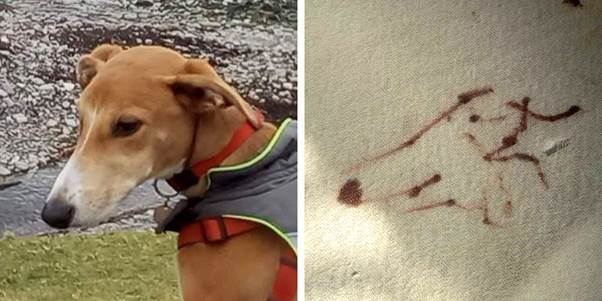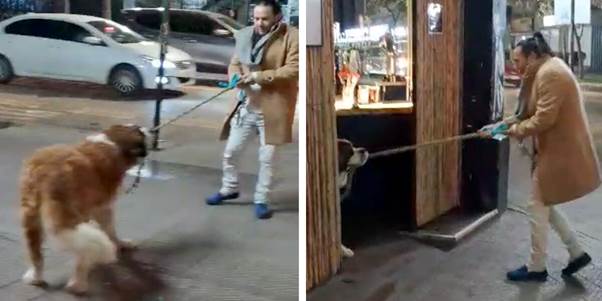Erik’s Brown Masterpiece: A Study in Canine Chaos and Accidental Genius
Erik, an adorable 7-month-old mixed-breed pup, resided in the UK, a fluffy, four-legged whirlwind of mischief who belonged to Flora Neilson. When he was asleep—which, mercifully, happened most often late at night and in sudden, gravity-defying naps—Erik was the epitome of peace and tranquility. A sprawl of soft, pale brown fur, he would lie motionless, his tiny paws twitching in dreams of chasing phantom squirrels. But let no one be fooled. This pup possessed an entirely different side, an engine of non-stop investigation and perpetual motion that taxed the limits of Flora’s patience and the structural integrity of her humble flat. Flora, a warm and pragmatic woman, often observed her companion with a mixture of profound affection and utter disbelief. “I think, perhaps, he’s been bred with a monkey,” Neilson would lament to anyone who asked how puppy training was going. “He continuously seems to be sniffing, hunting out anything that he can put in his mouth on, just like a toddler would. I have to watch him like a hawk.” This need for constant, high-level surveillance was not hyperbole; it was the essential condition of Flora’s life. To turn her back was to invite ruin. To step into the kitchen for two minutes was to risk the complete and total deconstruction of an essential household item. Every shoe, every scatter cushion, every magazine on the low coffee table existed under a state of martial law, always one unguarded moment away from becoming a victim of Erik’s tireless, teething curiosity. Chapter I: The War of Attrition Life with Erik was a sustained war of attrition waged against order. Flora had long ago abandoned the idea of a minimalist home and embraced a fortified existence. Cables were zip-tied and hidden behind furniture fortresses. The laundry basket was kept on top of the washing machine. The bottom shelves of the bookcase now housed only heavy, inedible dictionaries. Yet, Erik possessed a genius for finding the loophole, the forgotten detail, the Achilles’ heel of any defense. He once managed to drag an entire sack of potatoes from the pantry, rolling them individually across the living room floor before successfully puncturing three of them with rapid-fire precision, leaving the carpet covered in damp earth and starch. On another occasion, he performed an impromptu extraction of all the stuffing from a throw pillow, turning the living room into a snow globe of polyester fluff within the time it took Flora to answer the postman. Flora had captured evidence of these daily skirmishes, photographic exhibits that served as both a warning to prospective puppy owners and a personal record of his rampaging charm. Here’s an example of what Flora learned to expect if she allowed her attention to waver for a mere minute: a mangled remote control, a half-chewed sock, or a pile of shredded paperwork, usually containing the one bill she absolutely needed to keep. But Erik’s rambunctiousness didn’t only leave pure destruction in its wake. Sometimes, rarely, it resulted in something unexpected—something almost… artful. The day of the masterpiece began with a deceptively calm atmosphere. Flora had been grading a stack of college essays, a task that demanded deep concentration and the wearing of noise-canceling headphones. It was the perfect storm of distraction. Flora was physically present, yet mentally miles away, lost in the academic debate over Chaucer. Erik had already exhausted his morning’s official play inventory. He lay on the edge of the sofa, watching the faint movements of a dust mote dancing in the afternoon sunlight. The soft, woven fabric of the sofa cushion, a pale grey, was his favorite resting spot, a landscape intimately known to his paws and teeth. He began his investigation subtly. His nose, always moist and highly tuned, twitched, picking up a faint, sharp, chemical odor—the alluring scent of the forbidden. It was coming from the floor beside the couch, near the small magazine rack. Flora had been labeling boxes for storage the night before, and in her exhaustion, she had dropped the tool of her trade: a brown permanent marker. It was a robust pen, designed for writing on industrial packaging, with a thick barrel and an even thicker cap. It was dark, rich brown, the color of wet earth or strong coffee. To Erik’s sensitive snout, it screamed novelty. He slid silently off the couch—a smooth, almost liquid movement that belied his seven months and already considerable puppy weight. He nudged the pen out from under the rack. He didn’t chew it immediately. He held it gently in his mouth, the smooth plastic surprisingly pleasant against his gums. This was a treasure, a secret. The crime scene of choice was the softest, most welcoming surface available: the couch cushion. It was elevated, it was comfortable, and it provided just the right resistance for his delicate operation. The critical phase was uncapping. Erik placed the marker onto the cushion, pinning it firmly with his left paw. He worked at the cap with the side of his mouth, twisting his head and testing the plastic boundary between him and the ink. The process was messy, utilizing saliva and sheer, puppy-powered leverage. Finally, with a satisfying, almost triumphant thwack, the cap flew free. The smell intensified. The marker was now exposed, glistening with its rich, brown pigment. Erik immediately began to work, his movements driven by instinct rather than conscious artistic intent. He grabbed the marker and began to gnaw, testing the hard nib and the plastic casing. The first action—the grinding, exploratory chew—pushed the chisel tip deep into the fabric, releasing a dense, spreading pool of rich brown ink. This formed the central, dark core of the image, a chaotic, textured mass that suggested the voluminous fuzz of his head and neck. Next, driven by the desire to reposition the unwieldy chew toy, he shook his head violently. This movement, a full-body jolt, dragged the marker across the cushion, leaving a wide, sweeping arc of brown lines—the expressive, undefined, kinetic energy surrounding his face. It was
Erik’s Brown Masterpiece: A Study in Canine Chaos and Accidental Genius Read More »



